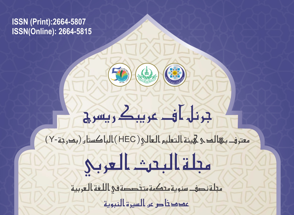الأساليب البديعية فى شعر حافظ إبراهيم Innovative styles in Hafiz Ibrahim’s poetry Section Articles
##plugins.themes.academic_pro.article.main##
Abstract
In this article, we mentioned the exquisite style of Hafiz Ibrahim. Hafiz was one of the greatest poets and writers of the modern era in the land of Egypt. He spent his entire life in jihad against oppressive forces and was the voice of the oppressed. SO, Hafiz used the colloquial language to make his speech effective. He also used the methods of exquisite science. So that the listener does not get bored, in this article I have embodied these methods (quotation, interview, inlay...) as an example.
Hafiz Ibrahim's style is characterized by simplicity and depth at the same time, as he uses language directly and effectively to convey feelings and ideas. His excellence is evident in the choice of words and their consistency with the structure of the poem, which makes his poems easy to understand and comprehend for the reader, and at the same time instill depth and Meditation.
His style varies between sentimentality, symbolism, and similes, which gives his poems a unique and attractive character that entertains the reader and stimulates contemplation and thought. Hafiz Ibrahim used poetic images brilliantly, as he embodied scenes and situations in a way that stimulates the imagination and stimulates emotions. He used poetic structures in an elaborate manner, and this appears through the diversity of the rhyme of the verses and the smooth and harmonious interweaving of ideas.
In short, Hafiz Ibrahim’s style in his poetry is considered exquisite and beautiful, mixing art, aesthetics, and philosophical depth, which made him the focus of attention of readers and lovers of Arabic poetry throughout the ages.
KEYWORDS:

